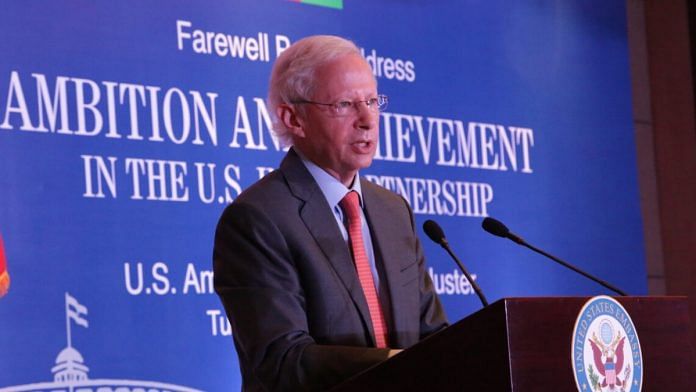New Delhi: For the past 18 months, the position of US ambassador to India has remained vacant. This is the “longest-ever stretch” where India has not had an ambassador from the US, according to data compiled by US-based think tank Center for Strategic and International Studies (CSIS).
Experts say the absence of an ambassador in New Delhi has not gravely affected diplomatic relations, but add that it is “not the best look”.
According to a graph prepared by Richard Rossow, Wadhwani Chair in US-India Policy Studies at CSIS, American ambassadors to India have usually taken office within six to seven months of the departure of their predecessors.
This means that the current gap — which continues to widen as the nomination of President Joe Biden’s pick, Los Angeles Mayor Eric Garcetti, remains stalled in the Senate — is more than double the average.
The term of the previous US envoy, Kenneth Juster, came to an end in January 2021. Since then, there have been four interim envoys, officially known as Chargé d’Affaires, Donald Heflin (January-May 2021), Daniel Smith (May-June 2021), Atul Keshap (June-September 2021) and Patricia A. Lacina (September-present).
According to Rossow, the seniority of an ambassador is necessary for smoothening bureaucratic and diplomatic processes.
“The Indian government is fairly hierarchical, so we may have difficulties getting certain levels of meetings. Politically connected ambassadors can circumvent the US government bureaucracy when needed to get momentum on new ideas,” Rossow told ThePrint in an email.
“And ambassadors from the foreign service, with their seniority and internal connections in the State Department, often have an easier time getting different offices to engage and building momentum on key programme.”
Diplomatic relations between India and the US, and the American Embassy at New Delhi, were established on 1 November 1946, when the US State Department raised the American Mission at New Delhi to an Embassy. An interim Indian government was in office at the time ahead of the country’s Independence from the British the following year.
Henry F. Grady, the first US Ambassador to India, was appointed in 1947.
Also Read: Nehru’s 1949 ‘goodwill tour’ of US & how it opened a new chapter in bilateral relations
‘Doesn’t send a good message’
Former diplomat Vijay K. Nambiar noted that the record-long vacancy of the post comes at a time when India-US relations were reaching their “most critical phase”, and, from America’s point of view, a long-term view in terms of the strategic relationship was needed.
“Despite the absence of an ambassador for so many months, US-India relations, especially in terms of the Quad and other factors, have not been affected. This is probably owed to External Affairs Minister S. Jaishankar’s deep knowledge of the entire range of substantive issues as well as his familiarity with US officials,” he told ThePrint.
“Then again, it isn’t exactly the best look to leave the post vacant for so long and at such a critical time.”
Former foreign secretary Kanwal Sibal concurred that it doesn’t send a good message. “Major changes are taking place internationally and regionally, especially the fallout from the Ukraine conflict. Interpreting and reporting India’s position on various issues at a more responsible level from the US mission will be more helpful,” he said. “Of course, at the political leadership level, contacts are being maintained between the two sides, and we have an ambassador in Washington.”
Asked if the US President could possibly put forth another name instead of Garcetti’s, Sibal said: “The fate of Garcetti’s nomination, I understand, has sensitivities within the US political system. Hence, the drift that we see.”
Also Read: US arm-twisting India on ‘human rights abuses’ ended with handshake. But Delhi got the signal
Second-longest gap was 16 months
The second-longest gap between US ambassadors to India was 16 months, when Thomas Pickering, who departed in March 1993, was replaced by Frank Wisner in July 1994, according to the CSIS data.
India-US relations were tense then due to differences over the Kashmir issue and Washington’s concerns over nuclear-weapon proliferation.
Pickering was transferred out of New Delhi to Moscow. It was around the time then-US assistant secretary for South Asia, Robin Lynn Raphael, said at a press gathering that America didn’t recognise the 1947 Instrument of Accession under which Maharaja Hari Singh ceded Kashmir to India. The comment had created a furore in India.
“In April 1993, Thomas Pickering, the senior US ambassador, was transferred, after only a few months in Delhi, to Moscow. As if this was not bad enough, the nomination of his projected successor, New York Congressman Stephen Solarz, was held up reportedly for a year, reportedly by FBI background checks,” author Raymond Cohen wrote in his book ‘Negotiating Across Cultures: International Communication in an Interdependent World‘.
In April 1994, during a visit to India, the then US Deputy Secretary of State Strobe Talbott floated Wisner’s name instead, the book says.
One report noted that the vacancy of the ambassadorship leading up to this had “deeply insulted New Delhi”.
(Edited by Tony Rai)
Also Read: Seeing past Russia, US says ‘able & willing’ to be India’s partner of choice, recalls Nehru-Truman



